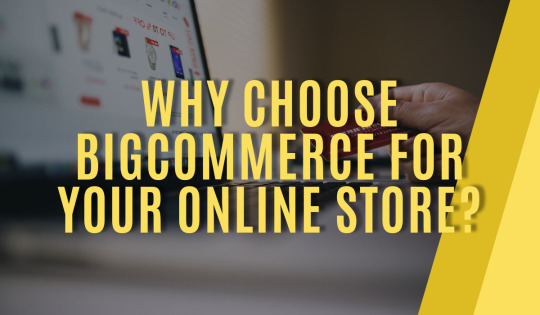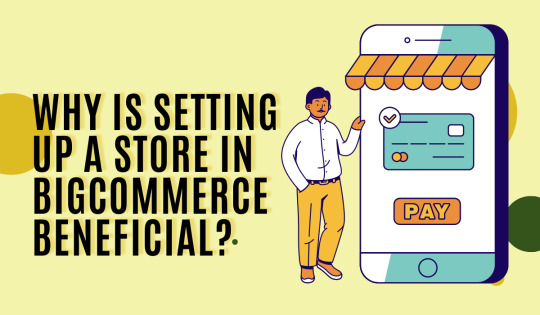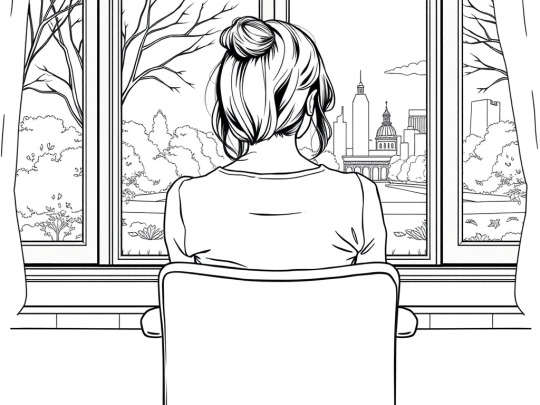#codetricks
Explore tagged Tumblr posts
Video
youtube
Accordion Element with HTML & CSS only
1 note
·
View note
Text
Why choose BigCommerce for your online Store?

Introduction
BigCommerce was founded in 2009, growing to be a business of more than 25 billion dollars, with more than 600 employees. It justifies the use of the word “Big” in its title. It is a premium e-commerce site that is used by all kinds of enterprises to set up their online stores and customize them according to their requirements. All kinds of products and services can be sold on this platform.
A major reason for its popularity among businessmen is that it enables them to access the store from anywhere and is a SaaS (Software as a Service) which means that all the tools they need to set up the store are available to them, from themes to layouts, which is beneficial to them. If you are looking to set up your store on Big Commerce, it is required for you to know more about this platform before using it for your future use.
Features of BigCommerce
Customization
Store Customization is the practice of editing, and customizing your storefront using the tools and design templates provided in the program. The drop-and-drag visual editing tool is used in BigCommerce to add design and customized elements and the biggest merit is that you do not need to write any codes. This is helpful for beginners and people from non-technical backgrounds which makes it likable and profitable for businesses.
CMS
Content is one of the ways through which you can associate with your customers and even invite visiting users into becoming one. That is why it is integral for you to focus on managing the content of the website.
Publishing quality content, and constant updates about newly launched products, events, news, etc helps in connecting with your audience better which in turn enhances brand awareness. BigCommerce has an effective and stable CMS which will help you in promoting your content and raising your rank in the SERPs which is a big boost to your business.
Design Themes
It provides a large number of built-in themes that are open to editing and changes, which means, you have the freedom to let your imagination flow and customize them according to your wish. The themes are developed using HTML, JavaScript, and CSS which is easily learned and even a beginner who knows these can create new themes and design templates on this platform.
Speed
Site speed is important for your business to be noticed. Smooth and fast loading speed ensures more traffic and higher ranking. Since BigCommerce is supported by Google AMP, Google Cloud Platform structure, and Akami Manager Built In, you can rest assured that the site speed of your store will be excellent.
Payment
BigCommerce supports a lot of cashless payment options like Amazon Pay, Apple Pay, and PayPal, along with other digital wallets that make the checkout process transparent and easier on both the client and seller’s side.
You can operate stores on multiple platforms such as Instagram, Facebook, Amazon, etc because it provides a cross-platform structure. This means that you get to connect with a larger audience and increase sales of your services and products.
Industries using BigCommerce
BigCommerce is very popular in the business world. Many established and large companies use this e-commerce platform to boost their sales and generate revenue and create brand awareness. With many tools and techniques unique to it, BigCommerce offers many packages that businessmen can choose from according to their business plans. Some of the big names that can be found on this platform are-
Sony
Almanac
Casio
RAZER
Game Nerds
Dremel
Why is setting up a Store in BigCommerce Beneficial?

BigCommerce has a strong foothold in the business sector because of the many features and benefits that come with this platform. Some of the best advantages you are guaranteed while setting up your store in BigCommerce are as follows.
Easy Usage
It is easy to set up and use. This is especially beneficial for people who are beginners or don't have a technical background. They can quickly and efficiently set up a fully functional online store with tools and techniques that are provided by the platform without the need for writing any code or downloading additional apps or plugins. As a result, BigCommerce can compete successfully with other e-commerce websites.
Website Optimization
SEO (Search Engine Optimization) is a very critical part of online business. Optimization of your store or website can drastically improve your standing in the industry and you get to have many opportunities for increasing your rank in the SERPs. BigCommerce follows the latest SEO practices that help you in optimization, enriching your website with appropriate keywords, and checking for any malicious content that might be a threat to your ranking.
Customer Satisfaction
It provides quality customer service to all the users who visit online stores. It includes a feedback and query forums, 24/7 customer support, a short waiting period, quick checkout and payment services, etc. These factors must be taken into consideration to ensure that your business offers quality customer service.
Conclusion
Since the past few years, BigCommerce has taken up a stable position in e-commerce. It is convenient, efficient, user-friendly, and quick, which is why it is an ideal program for all kinds of businesses. So, if you want to start your online business, BigCommerce is the one for you.
#BigCommerceDevelopment#eCommerce#OnlineStore#WebDevelopment#WebDesign#WebDevelopmentTips#WebDevelopmentTricks#WebDevelopmentTutorials#WebDevelopmentResources#WebDevelopmentCommunity#CodeSnippet#CodeTips#CodeTricks#CodeTutorials#CodeResources#PHPDevelopment#JavaScriptDevelopment#CSSDevelopment#HTMLDevelopment
0 notes
Text
Not Just Ill: Redefining My Chronic Condition

Dealing with an invisible chronic illness isn’t easy. Beyond the fatigue, physical pain, and brain fog, there’s another layer of struggle: people don’t see how unwell you are. They see the outside—maybe a sun-kissed face, some makeup, a well-put-together outfit, a warm greeting—and they draw their own conclusions.
They see you show up at a birthday party and think, “She must be doing better.” They don’t know that you had to sleep for two hours beforehand and will now be in bed—or glued to the couch—for the next three to five days because you went. They ask how you're doing, and you say, “I'm fine.” Not because it’s true, but because sometimes you're simply tired of talking about being sick.
In my case, I really do get sick of talking about being sick.
So yes, people sometimes assume I’m better than I am. Some may even think I exaggerate my illness. After all, lots of people are tired—and they still get up and go to work. Why can’t I?
It’s okay. I understand how society copes with things it can’t see or make sense of: it labels, defines, reduces. It filters experience through its own lens so the unfamiliar becomes manageable. Living with an invisible illness for the past five years has taught me to tune out those voices. I’ve learned to define myself based on my own sense of worth, not the value placed on me by others.
When ‘Illness” becomes “Disability”
Still, that definition of self took a jolt last week. While doing research for my book on invisible illnesses, I came across something unexpected: several major health organizations now classify my condition as an invisible disability. That word stopped me cold.
According to the World Health Organization’s World Report on Disability (2011), disability is defined using the International Classification of Functioning, Disability and Health (ICF), which breaks down functioning into three interconnected categories:
Impairments: problems with body function or structure
Activity limitations: difficulties in executing tasks or actions
Participation restrictions: challenges with involvement in life situations
Disability, then, isn’t about one diagnosis—it’s about how health conditions interact with personal and environmental barriers to limit engagement in life. The ICF uses neutral language and doesn’t distinguish between physical or mental origins. If your condition affects your ability to function and participate fully, it qualifies.
Suddenly, I found myself staring at the screen thinking: Wait. You mean I’m disabled?
The word “disability” has always carried a specific image in my mind—something concrete, visible, undeniable. I never thought to put my illness, or any chronic illness, in that category. Illness felt like a challenge, something to fight, to manage, to overcome. Disability felt... definitive. Permanent.
But that’s the thing: having a chronic illness is a disability. It impacts my ability to participate in society. It limits what I can do. It interferes with basic functioning. And it’s real, whether people see it or not.
Seeing the Unseen
According to Hidden Disabilities Sunflower, one in six people globally live with a disability. Of those, an estimated 80% are non-visible. That’s over a billion people, most of them unseen—and undervalued. Yet every one of them has something meaningful to offer. We want to engage. We want to be included. We deserve the space to contribute.
Maybe “disability” is a better word after all. “Illness” often implies recovery is coming, or should be. There’s an unspoken apology in it, a pressure to heal. “Disability,” on the other hand, demands society’s acceptance. It calls for accessibility, empathy, and policy that affirms our worth.
So here I am: a woman with an invisible disability. And an awful lot to give—to those who acknowledge my boundaries, honor my integrity, and respect my value.
Maybe it’s time we all reconsider what disability really looks like—and who we assume doesn’t carry it.
If you enjoy reading my insights and would like to stay updated on my latest posts, please subscribe to my blog for email notifications. Subscription is free!
Source: Not Just Ill: Redefining My Chronic Condition
0 notes
Text
How to make a Simple animated 3D Buttons using CSS & HTML
youtube
0 notes
Text
Simple Toggle Switch | HTML&CSS
youtube
0 notes
Text
Custom Input Range | HTML & CSS & jQuery
youtube
0 notes
Text
Not Just Ill: Redefining My Chronic Condition

Dealing with an invisible chronic illness isn’t easy. Beyond the fatigue, physical pain, and brain fog, there’s another layer of struggle: people don’t see how unwell you are. They see the outside—maybe a sun-kissed face, some makeup, a well-put-together outfit, a warm greeting—and they draw their own conclusions.
They see you show up at a birthday party and think, “She must be doing better.” They don’t know that you had to sleep for two hours beforehand and will now be in bed—or glued to the couch—for the next three to five days because you went. They ask how you're doing, and you say, “I'm fine.” Not because it’s true, but because sometimes you're simply tired of talking about being sick.
In my case, I really do get sick of talking about being sick.
So yes, people sometimes assume I’m better than I am. Some may even think I exaggerate my illness. After all, lots of people are tired—and they still get up and go to work. Why can’t I?
It’s okay. I understand how society copes with things it can’t see or make sense of: it labels, defines, reduces. It filters experience through its own lens so the unfamiliar becomes manageable. Living with an invisible illness for the past five years has taught me to tune out those voices. I’ve learned to define myself based on my own sense of worth, not the value placed on me by others.
When ‘Illness” becomes “Disability”
Still, that definition of self took a jolt last week. While doing research for my book on invisible illnesses, I came across something unexpected: several major health organizations now classify my condition as an invisible disability. That word stopped me cold.
According to the World Health Organization’s World Report on Disability (2011), disability is defined using the International Classification of Functioning, Disability and Health (ICF), which breaks down functioning into three interconnected categories:
Impairments: problems with body function or structure
Activity limitations: difficulties in executing tasks or actions
Participation restrictions: challenges with involvement in life situations
Disability, then, isn’t about one diagnosis—it’s about how health conditions interact with personal and environmental barriers to limit engagement in life. The ICF uses neutral language and doesn’t distinguish between physical or mental origins. If your condition affects your ability to function and participate fully, it qualifies.
Suddenly, I found myself staring at the screen thinking: Wait. You mean I’m disabled?
The word “disability” has always carried a specific image in my mind—something concrete, visible, undeniable. I never thought to put my illness, or any chronic illness, in that category. Illness felt like a challenge, something to fight, to manage, to overcome. Disability felt... definitive. Permanent.
But that’s the thing: having a chronic illness is a disability. It impacts my ability to participate in society. It limits what I can do. It interferes with basic functioning. And it’s real, whether people see it or not.
Seeing the Unseen
According to Hidden Disabilities Sunflower, one in six people globally live with a disability. Of those, an estimated 80% are non-visible. That’s over a billion people, most of them unseen—and undervalued. Yet every one of them has something meaningful to offer. We want to engage. We want to be included. We deserve the space to contribute.
Maybe “disability” is a better word after all. “Illness” often implies recovery is coming, or should be. There’s an unspoken apology in it, a pressure to heal. “Disability,” on the other hand, demands society’s acceptance. It calls for accessibility, empathy, and policy that affirms our worth.
So here I am: a woman with an invisible disability. And an awful lot to give—to those who acknowledge my boundaries, honor my integrity, and respect my value.
Maybe it’s time we all reconsider what disability really looks like—and who we assume doesn’t carry it.
If you enjoy reading my insights and would like to stay updated on my latest posts, please subscribe to my blog for email notifications. Subscription is free!
Source: Not Just Ill: Redefining My Chronic Condition
0 notes
Text
Smooth Scrolling with jQuery
youtube
0 notes
Text
Not Just Ill: Redefining My Chronic Condition

Dealing with an invisible chronic illness isn’t easy. Beyond the fatigue, physical pain, and brain fog, there’s another layer of struggle: people don’t see how unwell you are. They see the outside—maybe a sun-kissed face, some makeup, a well-put-together outfit, a warm greeting—and they draw their own conclusions.
They see you show up at a birthday party and think, “She must be doing better.” They don’t know that you had to sleep for two hours beforehand and will now be in bed—or glued to the couch—for the next three to five days because you went. They ask how you're doing, and you say, “I'm fine.” Not because it’s true, but because sometimes you're simply tired of talking about being sick.
In my case, I really do get sick of talking about being sick.
So yes, people sometimes assume I’m better than I am. Some may even think I exaggerate my illness. After all, lots of people are tired—and they still get up and go to work. Why can’t I?
It’s okay. I understand how society copes with things it can’t see or make sense of: it labels, defines, reduces. It filters experience through its own lens so the unfamiliar becomes manageable. Living with an invisible illness for the past five years has taught me to tune out those voices. I’ve learned to define myself based on my own sense of worth, not the value placed on me by others.
When ‘Illness” becomes “Disability”
Still, that definition of self took a jolt last week. While doing research for my book on invisible illnesses, I came across something unexpected: several major health organizations now classify my condition as an invisible disability. That word stopped me cold.
According to the World Health Organization’s World Report on Disability (2011), disability is defined using the International Classification of Functioning, Disability and Health (ICF), which breaks down functioning into three interconnected categories:
Impairments: problems with body function or structure
Activity limitations: difficulties in executing tasks or actions
Participation restrictions: challenges with involvement in life situations
Disability, then, isn’t about one diagnosis—it’s about how health conditions interact with personal and environmental barriers to limit engagement in life. The ICF uses neutral language and doesn’t distinguish between physical or mental origins. If your condition affects your ability to function and participate fully, it qualifies.
Suddenly, I found myself staring at the screen thinking: Wait. You mean I’m disabled?
The word “disability” has always carried a specific image in my mind—something concrete, visible, undeniable. I never thought to put my illness, or any chronic illness, in that category. Illness felt like a challenge, something to fight, to manage, to overcome. Disability felt... definitive. Permanent.
But that’s the thing: having a chronic illness is a disability. It impacts my ability to participate in society. It limits what I can do. It interferes with basic functioning. And it’s real, whether people see it or not.
Seeing the Unseen
According to Hidden Disabilities Sunflower, one in six people globally live with a disability. Of those, an estimated 80% are non-visible. That’s over a billion people, most of them unseen—and undervalued. Yet every one of them has something meaningful to offer. We want to engage. We want to be included. We deserve the space to contribute.
Maybe “disability” is a better word after all. “Illness” often implies recovery is coming, or should be. There’s an unspoken apology in it, a pressure to heal. “Disability,” on the other hand, demands society’s acceptance. It calls for accessibility, empathy, and policy that affirms our worth.
So here I am: a woman with an invisible disability. And an awful lot to give—to those who acknowledge my boundaries, honor my integrity, and respect my value.
Maybe it’s time we all reconsider what disability really looks like—and who we assume doesn’t carry it.
If you enjoy reading my insights and would like to stay updated on my latest posts, please subscribe to my blog for email notifications. Subscription is free!
Source: Not Just Ill: Redefining My Chronic Condition
0 notes